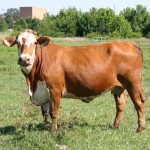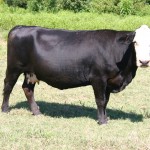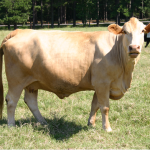Focus on Body Condition for Most Efficient Females and Bulls
By Dr. Whitney Whitworth, Lyssy & Eckel Feeds
Ensuring a successful breeding season begins long before the bulls are turned out. Planning and some key management steps can make a difference in the number of calves born and also your bottom line. Areas where I see many producers can make improvements include proper conditioning of both bulls and cows, implementation of a vaccination program and fertility testing of bulls.
 In my experience, cattlemen and women view proper condition differently. If we were to poll a group of cattlemen, we would get a wide range of responses as to what an animal in ‘good’ body condition looked like. Fertility can be greatly impacted if a female is not in proper condition, whether that be too fat (body condition 7 or higher) or too thin (body condition 4 or lower). To take this a step further, it is not uncommon for cattle in extremely thin or fat body condition scores (BCS) to not be cyclic and fail to have standing heats, therefore never getting bred. Females are the most efficient in just about every production measurement: from breeding to calving to processing forage, when they are in a BCS ranging from 5 to 7 on a scale of 1-9. Even among people who condition score cattle every day there are subjective opinions as to what a cow looks like in a BCS 4 or 5, 5 or 6, etc. For example, a cow I may see as a condition score 5 may appear to be a condition score of 6 to another cattleman. If you choose to keep BCS as part of your records, it is important for the same person to perform the condition scoring every time scores are taken. That way, we have consistency in the type of information our animals are giving us. The cows pictured here are in what I consider ‘good’ shape and are body condition scores in the mid-range of 5-6 to give you an idea of how your cows compare.
In my experience, cattlemen and women view proper condition differently. If we were to poll a group of cattlemen, we would get a wide range of responses as to what an animal in ‘good’ body condition looked like. Fertility can be greatly impacted if a female is not in proper condition, whether that be too fat (body condition 7 or higher) or too thin (body condition 4 or lower). To take this a step further, it is not uncommon for cattle in extremely thin or fat body condition scores (BCS) to not be cyclic and fail to have standing heats, therefore never getting bred. Females are the most efficient in just about every production measurement: from breeding to calving to processing forage, when they are in a BCS ranging from 5 to 7 on a scale of 1-9. Even among people who condition score cattle every day there are subjective opinions as to what a cow looks like in a BCS 4 or 5, 5 or 6, etc. For example, a cow I may see as a condition score 5 may appear to be a condition score of 6 to another cattleman. If you choose to keep BCS as part of your records, it is important for the same person to perform the condition scoring every time scores are taken. That way, we have consistency in the type of information our animals are giving us. The cows pictured here are in what I consider ‘good’ shape and are body condition scores in the mid-range of 5-6 to give you an idea of how your cows compare.
I cannot emphasize enough that it is much easier to keep a cow in proper condition than it is to put weight on her. And, if you have some cows that need to gain weight, the most efficient time to do that is in the last trimester of her pregnancy. At that time, the previous year’s calf should be weaned and thus her nutritional requirements will be diminished. So, any extra nutrition provided by the producer can be the most beneficial. In bulls, keeping them in good shape is key as well. Sperm production can be negatively impacted by dramatic weight loss. In my experience, what some producers see as ‘too fat’ will actually be good shape for bulls to be in. At the same time, a bull which is in fact too fat can become lazy and fail to service the necessary females.
As producers, I think we sometimes don’t consider what we ask of our females. We ask her to get pregnant, calve, raise that calf and then get rebred again. To maintain a yearly calving interval, she must breed within 80-85 days after calving. That time period happens to coincide with peak lactation. So, we need to keep in mind that we are asking the most of a cow when she is under the most stress. Here is a prime time when we can help our cattle. If we put in some extra effort prior calving season until the bulls are put out, it can make a difference in our conception rates and thus our calving rates next year. For optimum efficiency, a cow needs to calve in a body condition score of at least 5, for heifers it should be a 6. This is incredibly important to consider as most females will drop a condition score as soon as they calve. In some cases, they can drop close to 100 pounds or more between the weight of the calf and the associated fluids. So, supplemental feeding both prior to calving and also during the most stressful parts of lactation is very important. There is no ‘best fit’ supplementation program which applies to every herd or situation. If you have an extensively managed herd where you only get to see your cattle once per week or even less often, then using protein tubs as a supplement could be a good fit. If you are a producer
who feeds your cows several times per week, then a cube or cake might be better suited to your goals. If possible, it is ideal to have first and second calf heifers in a pasture where they can get more attention and more feed. These females are still growing and thus have even more stress than what we place on mature females. They will need more supplemental feed and possibly assistance during the calving process. If they are in a pasture with a group of mature females, they most likely not get the advantage of any supplemental feed due to the dominance of the older cows. As a producer, you may even want to ‘hand feed’ young animals every day. In that case, a textured or sweet feed may even be more desirable.
It is also critically important to provide a mineral supplement to your herd, whether that be in block, tub or loose mineral form. The type and composition of the mineral can vary based on geographic location of your herd. At my family operation, we worry quite a bit about phosphorous because we have soils rich in calcium and we want to maintain a proper 2:1 calcium to phosphorous ratio. But, when I worked in southeast Arkansas which is a selenium deficient area, we made sure that it was added to our mineral. Your local extension service can assist you in having your soil tested to find out if there are deficiencies which need to be corrected.
I believe every operation should have a vaccination program. The US beef cattle herd has changed dramatically in the last twenty years, both in number and in composition. Research has shown that there are several hundred thousand cattle on the highway on any given day and many animals have trips over twenty hours, thus being exposed to many different pathogens and environments. Additionally, exposure to wild animals increases the chances that livestock may contract some type of illness. Your best course of action to help your cattle combat exposure to disease is by implementing a vaccination program and keeping your animals on a good plane of nutrition. Your local large animal veterinarian is an excellent source of information about diseases in your area and thus what vaccinations may be necessary. In calves, a 7 or 8 way Clostridial vaccine is probably the cheapest insurance you can buy. Ideally, calves should have this vaccine prior to weaning and then receive a booster at weaning. For mature animals, vaccination protocols should be performed approximately 30-60 days before the beginning of the breeding season. For both cows and bulls, it is imperative to vaccinate yearly for the five strains of Leptospirosis. In fact, in some areas it is necessary to vaccinate twice or three times per year. When shopping for reproductive vaccines, the labels of should say VL5 or VL5 + HB. Whether or not you choose to include this vaccination with a five way respiratory viral vaccination is up to you, but as a producer, you should keep in mind that those diseases (IBR and BVD are examples), as well as Leptospirosis strains, are economically important causes of abortions in beef cattle.
Lastly, I would like to encourage you to work with your veterinarian and have all of your breeding bulls undergo a breeding soundness exam (BSE). A BSE will normally cost about $50 to $100 per animal. In the beef industry, this is not a widely used tool. But, if you can find out your bull is not fertile before the breeding season, it will allow you time to save your calf crop. As many as one in five bulls will not pass a BSE. During this test, a bull must meet standards on a physical examination as well as a semen test.  I have tested many bulls in my career, and looks can be deceiving. Just because an animal appears healthy, that does not guarantee he is fertile. Males which fail a BSE may pass a test at a later date, so it is important to perform testing at least 45 days prior to breeding. This will allow time for a bull to be retested, or to find another bull.
There is no farm or ranch has the same scenario where breeding and calving are concerned. Working with extension personnel and your veterinarian can be a very valuable tools for ensuring the best possible chances of success. If I can be of any assistance, please feel free to call my office at (325) 247-4147 or email me at whitney@lefeeds.com. This is a very exciting time to be in the beef business and I wish each of you the best in your upcoming breeding season!











